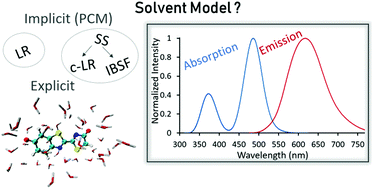The role of solvation models on the computed absorption and emission spectra: the case of fireflies oxyluciferin†
Abstract
Surrounding effects are crucial to successfully simulate the absorption and emission spectra of molecular systems. In this work we test different solvation models to compute transition energies and to simulate the spectra of oxyluciferin responsible for the light emission in fireflies and its derivatives. We demonstrate that, within the PCM model, the IBSF formalism is suitable for computing the transition energies of the oxyluciferin chemical forms characterized by a charge transfer character. On the other hand, the LR approach could be used for the chemical forms where an almost negligible charge transfer takes place. Moreover, we demonstrate that explicit solvation models, applied by QM/MM calculations, are needed to accurately reproduce the experimental shape of the spectra. Finally, the vibrationally resolved spectra using a solvation model (implicit or microsolvation) is computed. Some noticeable differences arise when considering the implicit solvation with respect to gas phase vibrational spectra, while small changes were found when explicit water molecules within a microsolvated model are considered.



 Please wait while we load your content...
Please wait while we load your content...